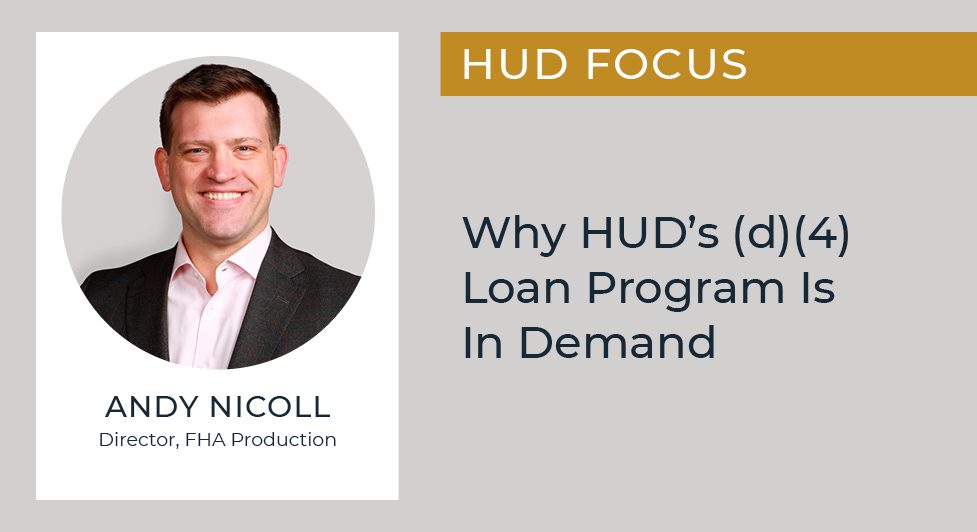This is part three of a four-part series on the latest financing opportunities under HUD.
As the U.S. Department of Housing and Urban Development (HUD) takes greater steps to address housing shortages, its Federal Housing Administration (FHA) Section 221(d)(4) program has become a key resource for multifamily borrowers and lenders around the country.
Compared to most bank and nonbank financing options for development and rehabilitation projects, HUD offers some of the most attractive terms available on the market. FHA Section 221(d)(4) loans are interest-only during the full construction period and convert to a fully amortizing 40-year term once construction is completed. The loans are fully assumable at a nominal cost subject to HUD and lender approval.
These non-recourse loans offer borrowers a high maximum loan-to-cost (LTC) ratio of up to 85% and low minimum debt-service coverage ratio (DSCR) of 1.176x for market-rate properties. In today’s interest-rate climate, the low minimum DSCR coupled with the 40-year amortization typically results in the highest loan proceeds available. Further, HUD is considering improving the LTC and DSCR ratios to 90%/1.11x DSCR.
Elevated interest rates and tight bank lending have driven a growing number of borrowers to multifamily loans insured by HUD. The 221(d)(4) program has become increasingly attractive after the FHA raised its multifamily large loan limit from $75 million to $125 million as of January 2024.
Navigating HUD’s Loan Production and Built-In Programs
While interest rates remain elevated, there are several options for those who don’t want to be stuck paying higher rates over the long term. HUD has built-in programs that allow borrowers to modify or refinance their loans when interest rates fall.
HUD’s interest rate reduction (IRR) program, for example, allows borrowers to reduce their interest rate with a streamlined loan modification application with limited due diligence and out-of-pocket cost. While it could be a year or more until rates substantially decrease, having the IRR option throughout the entire 40-year lifespan of a 221(d)(4) loan gives borrowers a reliable guarantee and peace of mind during periods of heightened uncertainty.
Similarly, another option for owners of FHA-insured properties is the Section 223(a)(7) refinance program, which, in addition to reducing the interest rate, allows for an increase in loan proceeds and extension of the loan term to generate additional debt service savings.
Finally, all FHA multifamily loans are fully assumable, subject to approval and a fee of 0.05% of the original loan amount if owners decide to sell their assets.
Steady Refinements for Better Borrower Experiences
As HUD works on refining its programs and upskilling its staff to meet the latest market demands, the outlook for the 221(d)(4) program remains largely favorable. HUD has increased its headcount in recent years and has focused on rigorous training for the new hires. Efficiencies gained during the COVID-19 pandemic, such as further allowance of electronic signatures, remain in place.
Further, HUD is planning to roll out its new Portal and Loan Underwriting System (PLUS) later this year which will create an improved portal for HUD, lenders, and other stakeholders to improve transparency and communication.
Finally, and maybe most important, HUD leadership continue to publicly acknowledge the need for more rental housing creation and more feasible financing options. The FHA multifamily production leadership overall has been putting a greater emphasis on “getting to yes” at a time of rising housing shortages around the country.
Understanding Key Criteria and Project Parameters
Given the longer application process required for HUD financing, including 221(d)(4) loans, developers need to get an early start and carefully prepare their loan applications.
The first step is to clearly understand the criteria and parameters that borrowers must adhere to. Having a track record of successful multifamily development is vital. For potential borrowers lacking sufficient experience, one option is to form a joint venture with a more seasoned development or construction partner. A HUD consultant is also an option for some first-time HUD borrowers.
Unlike bank financing, HUD loans are non-recourse and more asset based. While developer experience and creditworthiness are important, there is even more focus on the property location, pro forma rents, submarket housing supply, and other factors. Environmental issues are a key concern for HUD as well.
In addition to the longer timeline, other important considerations for developers are HUD’s requirement that the general contractor pay Davis Bacon wages to laborers, which may cause an increase in construction costs in some markets. Additionally, HUD requires sponsors to post escrows at closing for contingency and debt service.
Leveraging Lument’s HUD and FHA Expertise
Lument has been a leading HUD lender according to the MBA rankings for many years, a testament to the underwriting, closing, and servicing teams. Lument’s FHA multifamily team takes an on-the-ground approach with all insured multifamily loan transactions to help borrowers navigate today’s complex and often challenging market conditions.
Contact Lument for further insights into HUD’s multifamily lending initiatives and to learn more about market-specific opportunities under the 221(d)(4) program.
Through Andrew’s work at Lument and his involvement on the board of the SMAC Southeast Mortgagee Advisory Council, he frequently talks to industry stakeholders and HUD officials about future prospects through the Section 221(d)(4) program.

